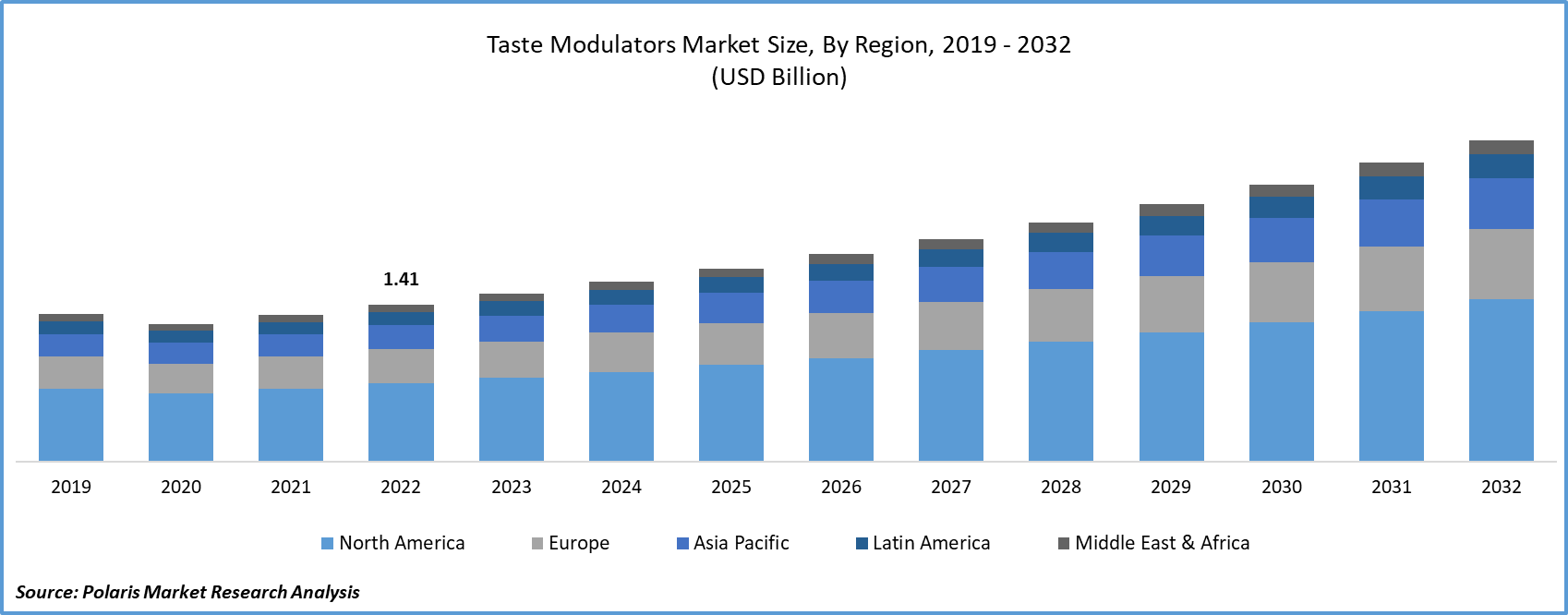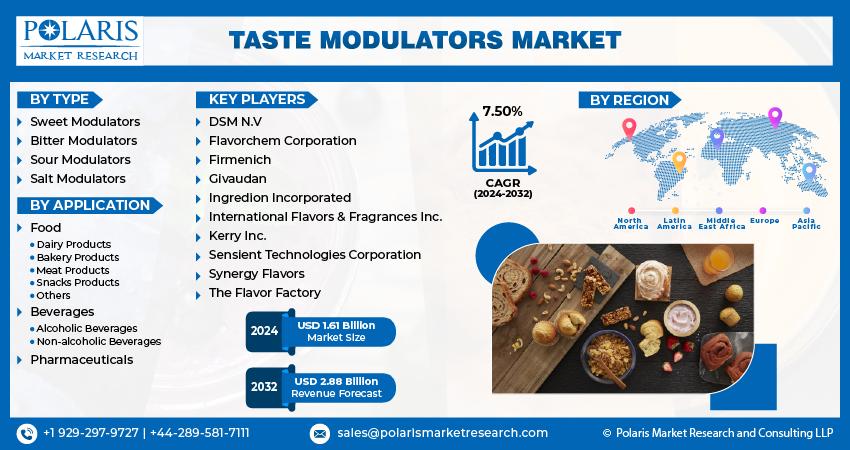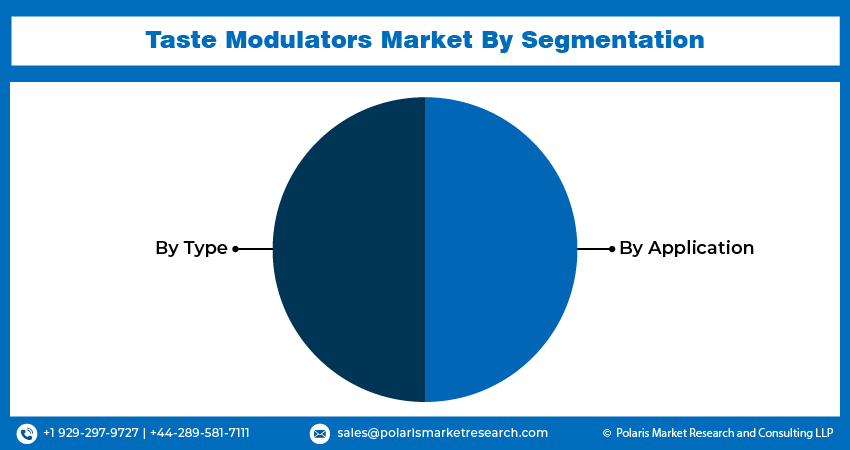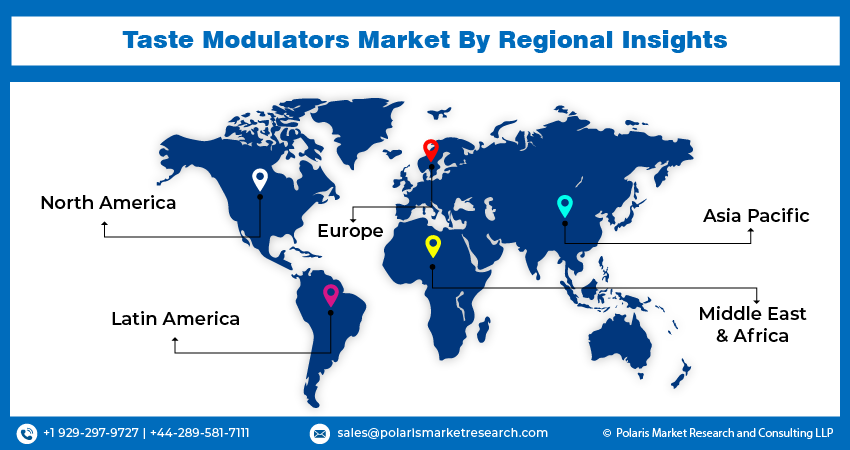
Taste Modulators Market Share, Size, Trends, Industry Analysis Report
By Type (Sweet Modulators, Bitter Modulators, Sour Modulators, Salt Modulators); By Application; By Region; Segment Forecast, 2024 - 2032
- Published Date:Jan-2024
- Pages: 114
- Format: PDF
- Report ID: PM4031
- Base Year: 2023
- Historical Data: 2019-2022
Report Outlook
The global taste modulator market size and share were valued at USD 1.51 billion in 2023 and is expected to grow at a CAGR of 7.50% during the forecast period.
The market research report offers an in-depth analysis of the industry to support informed decision-making. It offers a meticulous breakdown of various market niches and keeps readers updated on the latest industry developments. Along with tracking the taste modulator market on the basis of SWOT and Porter’s Five Forces models, the research report includes graphs, tables, charts, and other pictorial representations to help readers understand the key insights and important data easily.
Taste modulators are substances that enhance or alter the perception of flavors, including sweetness, bitterness, savoriness, saltiness, and more. They can either bind to the food product itself or when ingested, stimulate the brain to evoke a specific taste sensation. These compounds are also commonly referred to as flavor enhancers or masking agents. They replicate the taste profile of a given flavor without introducing the caloric content or other adverse effects associated with the original ingredient.
Dispensing the appropriate flavors can frequently be taxing as it needs a well-regulated consonance between varied constituents. In order to offer the desired taste, food manufacturers utilize impersonal flavors, which might or might not possess distinguishable flavors of their own. The taste modulator market size is expanding as some are utilized to adjust the flavor by boosting a particular allocation or by conquering off flavors, for instance, abolishing the pungency that is usually linked with protein bulwark. At the same time, others permit decreasing the aggregate of sugar or salt in commodities by increasing the degree of sweetness or saltiness.
However, the taste is not the sole element consumers supervise. The escalating demand for fit food and beverage alternatives has become a prominent driver of the food industry. Attempting to offer superior taste, fewer calories, and wholesome constituents frequently indicates that encountering one objective, such as lesser sugar and calories or appended nutritional value, causes the debasement of alternate areas, such as taste.

To Understand More About this Research: Request a Free Sample Report
- For instance, Sugar substitutes, or sweet modulators, replicate the delightful sweetness of sugar without replicating its detrimental impact on body weight, blood sugar levels, or heart health. Various industries, including dairy, bakery, meat, confectionery, packaged meals, and beverages, employ taste modulators.
Diabetes and obesity prevalence has been steadily increasing on a global scale. Two prominent contributors to excess calorie intake are the glycemic load in one's diet and the consumption of sugar-sweetened soft drinks. Obesity elevates the risk of a wide array of diseases, ranging from cancer to type-2 diabetes. High-intensity sweeteners, like sucralose, reduce calorie intake without sacrificing sweetness. However, they are often criticized for their undesirable taste when used in final products. Sweet modulators come to the rescue by eliminating these unfavorable flavors while maintaining the low-calorie content in various food and beverage items.
Advancements in food technology and flavor science have led to the development of more effective and versatile taste modulators. These innovations have enabled companies to create products with improved taste profiles while maintaining the desired nutritional attributes. The growing trend of plant-based and alternative protein-based products has also contributed to market growth. Taste modulators play a critical role in masking off-flavors often associated with these products, making them more appealing to a broader consumer base.
The COVID-19 pandemic has had a significant impact on the taste modulators market. As the virus spread globally and prompted widespread lockdowns and social distancing measures, the food and beverage industry faced numerous challenges. With the closure of restaurants, reduced dining out, and consumers prioritizing home-cooked meals, there was a shift in flavor preferences. Taste modulators saw fluctuations in demand.

Additionally, disruptions in supply chains and production facilities hindered the availability of certain taste modulators. Manufacturers and suppliers have had to adapt to these changing market dynamics by diversifying their product offerings and emphasizing the importance of taste modulation for overall consumer health and well-being.
Industry Dynamics
Growth Drivers
- Increasing demand for food and beverages products is boosting taste modulators market Growth
The taste modulator market growth of taste modulators during the forecast period is primarily driven by the surging demand of food and beverages products. The food and beverage sector is continually striving for innovation in the creation of clean-label products that are low in sugar, calories, and sodium, all while preserving the product's desired attributes, such as functionality, texture, and flavor. Taste modulators play a crucial role across diverse culinary categories, including pastries, meats, soups, sauces, bakery items, beverages, and dressings. As a result, the increasing desire for clean-label, shelf-stable, and delectable food offerings is fueling the global demand for taste modulators.
Internet and E-commerce have boosted the demand for healthier product options, especially among young individuals. Fitness influencers on social media have increased awareness of healthy lifestyles. The dairy, meat, and seafood sectors are thriving. Market players are incorporating taste modulators into bakery, confectionery, dairy, and meat products to cater to health-conscious consumers.
Report Segmentation
The market is primarily segmented based on type, application and region.
|
By Type |
By Application |
By Region |
|
|
|
To Understand the Scope of this Report: Speak to Analyst
By Type Analysis
- The sweet modulators segment dominates the market with the largest revenue share over the forecast period
The sweet modulators segment dominates the market with the largest revenue share. These substances are used to enhance or maintain the sweetness of food and beverages while reducing the sugar content. When sugar is added to a drink, it quickly dissolves in water and travels through saliva to reach the taste receptors on the tongue. The sweetness of sucrose, in particular, has a strong peak without any lingering aftertaste. On the other hand, High-Potency Sweeteners (HPS) have lower water solubility and take a longer time to reach the taste receptors, causing a delayed onset of sweetness perception. Furthermore, HPS has a sustained flavor presence due to its hydrophobic nature, which allows it to stick to hydrophobic proteins on the tongue.
Food and beverage manufacturers are using sweet modulators to meet the growing demand for health-conscious food products worldwide. Sports drinks and protein bars are two examples of products that are made with optimal nutritional profiles, thanks to sweet modulators like DOLCERRA from Ingredion and Modumax from DSM. This approach not only helps to control calorie content but also improves the health and well-being of consumers.
By Application Analysis
- The beverage segment accounted for the highest market share during the forecast period
The beverage segment accounted for the highest market share during the forecast period. Beverages are commonly enjoyed as refreshing drinks or as accompaniments to meals, consumed regularly and on various occasions. These drinks utilize ingredients such as sugar, salt, and other flavor enhancers to enhance their taste, texture, viscosity, and overall appeal. However, the consumption of beverages high in sugar or salt is considered unhealthy. In response, beverage producers are introducing healthier alternatives that retain the beloved taste with the assistance of taste modulators. This has led to an increased demand for these beverages, as consumers are now able to afford and choose healthier options due to the rising disposable income. Furthermore, the convenience of finding these beverages at nearby markets makes them easily accessible to consumers. The growing preference for healthier drinks is contributing to the expanding influence of the beverages segment within the taste modulators market.
Alcoholic beverages require the incorporation of a masking modulator to obscure or neutralize the inherent bitter notes within them effectively. The necessity for these modulators in the realm of beverage formulation is closely intertwined with the burgeoning worldwide consumption and the ever-rising demand for a diverse array of beverages.

Regional Insights
- North America dominates the market with the largest market share over the forecast period
North America dominates with the largest market share over the forecast period. The surge in obesity and diabetes cases has spurred a growing need for sugar-free edibles, beverages, and fat-free processed foods. Simultaneously, the increasing recognition of the advantages offered by taste modifiers is propelling the market's expansion. Additionally, the elevated per-capita income among the populace plays a significant role in the escalating demand for low-calorie, sugar-free, fat-free, health-oriented products despite their higher cost compared to traditional options. The mounting interest in healthier alternatives can also be linked to the surging popularity of sugar-free and fat-free products promoted by fitness, health, and lifestyle influencers on various social media platforms. Consumers are increasingly choosing nutritious and low-calorie food options. To cater to this trend, many businesses have developed taste modifiers like salt, fat, and sweet modulators.
Asia-Pacific is anticipated to grow fastest during the forecast period. Urbanization and Western influence are transforming dietary preferences, creating a growing market for taste modulators in the region. Rising disposable income is further driving this trend, reflecting a willingness to invest in innovative and value-added products, including those that use taste modulators. This presents significant growth opportunities for manufacturers and distributors of taste-modulator-enhanced offerings.
Governments in nations such as Thailand, Singapore, Australia, India, Hong Kong, and various others have instituted significant sugar tariffs in a bid to lower the prevalence of obesity and diabetes among consumers. Consequently, the food and beverage industry has pivoted towards using sugar alternatives to meet the demand for flavored and sweetened beverages while adhering to these regulations.

Key Market Players & Competitive Insights
The market is characterized by intense competition, with established players relying on advanced technology, high-quality products, and a strong brand image to drive revenue growth. These companies employ various strategies such as research and development, mergers and acquisitions, and technological innovations to expand their product portfolios and maintain a competitive edge in the market.
Some of the major players operating in the global market include:
- DSM N.V
- Flavorchem Corporation
- Firmenich
- Givaudan
- Ingredion Incorporated
- International Flavors & Fragrances Inc.
- Kerry Inc.
- Sensient Technologies Corporation
- Synergy Flavors
- The Flavor Factory
Recent Developments
- In July 2022, Ohly, a German yeast manufacturing firm, unveiled a trio of environmentally friendly components that enhance the functionality of plant-based food products. These components are integral to the Plant Protein Taste Toolbox, a series of solutions designed to cater to the needs of individuals following a vegan diet. Among these innovations is Flav-R-Max, a pioneering natural yeast flavor modifier that is carbon-neutral. It imparts a robust umami sensation and effectively masks any undesirable notes associated with plant proteins. Moreover, Flav-R-Max offers the added benefit of reducing the sodium content in meat substitutes.
- In May 2022, Flavorchem launched Taste Mod Sweet, a unique taste-enhancing solution designed specifically for beverage applications. This innovative taste modulator is crafted to amplify sweetness in beverages without compromising taste or nutritional value, making it an ideal choice for enhancing the sweetness of reduced-sugar drinks. Taste Mod Sweet exhibits its efficacy across a range of beverage types and pH levels, ensuring its versatility. Furthermore, it boasts vegan, kosher, and non-GMO credentials, allowing it to be labeled as a "natural flavor."
- In November 2021, Kerry, the global frontrunner in the realm of taste and nutrition, unveiled TastesenseTM Sweet Organic Certified, marking a significant milestone as the first organic-certified sweet modulator designed for the US beverage sector. This groundbreaking taste modulator serves as a versatile asset for the creation of Organic Certified beverages, imparting a clean, sweet flavor accompanied by a remarkable mouthfeel and a well-balanced taste profile. Its applications extend to a wide spectrum of beverages, including sparkling water, low- or no-sugar drinks, functional and energy beverages, as well as alcoholic drinks with varying levels of alcohol by volume (ABV)
Taste Modulators Market Report Scope
|
Report Attributes |
Details |
|
Market size value in 2024 |
USD 1.61 billion |
|
Revenue Forecast in 2032 |
USD 2.88 billion |
|
CAGR |
7.50% from 2024 – 2032 |
|
Base year |
2023 |
|
Historical data |
2019 – 2022 |
|
Forecast period |
2024 – 2032 |
|
Quantitative units |
Revenue in USD billion and CAGR from 2024 to 2032 |
|
Segments Covered |
By Type, By Application, By Region |
|
Regional scope |
North America, Europe, Asia Pacific, Latin America; Middle East & Africa |
|
Customization |
Report customization as per your requirements with respect to countries, regions, and segmentation. |
We provide our clients the option to personalize the taste modulator market report to suit their needs. By customizing the report, you can get data as per your format and definition. Also, the customization option allows you to gain a deeper dive into a specific segment, region, customer, or market competitor.
Browse Our Top Selling Reports
Mood Support Supplements Market Size, Share 2024 Research Report
Cumene Market Size, Share 2024 Research Report
Adzuki Beans Market Size, Share 2024 Research Report
Non-Potato Veggie Chips Market Size, Share 2024 Research Report
Soda Maker Market Size, Share 2024 Research Report
